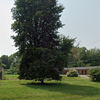Coming improvements to Carman Road, revised law and zoning chapter
GUILDERLAND — The town is set to receive $1.1 million in federal funds through the state’s Department of Transportation to do highway safety improvement along Carman Road.
The details are not yet finalized, Supervisor Peter Barber told the town board Tuesday night, but there will likely be two-way left-turn lanes at Lydius Street so drivers can make left turns off Carman Road onto Lydius Street, in either direction, without causing long lines of backed-up traffic. This intersection has an accident history, Barber said.
The town will continue to work with the state — which owns Carman Road — on the use of the award, Barber said, and will have people from its highway and water departments on site to make sure that work is consistent with the existing infrastructure and minimizes impact on residents.
Barber told The Enterprise that town officials have “had some concerns over the years, expressed in the Fort Hunter/Carman Road Neighborhood Transportation Plan,” which was a local study done as part of the town’s comprehensive plan. A central issue, he said, was improving traffic and pedestrian safety on Carman Road.
Recently, the town received a grant to complete the sidewalks that will link Carman Road to Lynnwood Elementary School.
Barber expects that this Carman Road safety improvement funding will also be used to lay sidewalks on both sides of Carman Road, “all the way to Ronald Place, and maybe further down, to Jessamine Lane.” The improvements, he said, will include high-visibility crosswalks and curbs that comply with the Americans with Disabilities Act, with cuts for wheelchair access.
Automatic sprinklers
Barber reminded residents that automatic sprinklers should not be used during the day, but only from 1 to 4 a.m. on odd-even days (if a home’s address is an even number, on even calendar days, etc.). “You should never see them pop up and come on, unless you’re a night owl,” he told The Enterprise.
The reason for this, Barber explained at the meeting, is to ensure that the town’s water tanks continue to have sufficient pressure to be able to pump enough water to hydrants in the case of fire.
Abandoned buildings law revised
At its last meeting, on June 21, the town board unanimously amended last year’s law on vacant and abandoned properties.
The changes, Barber explained at the meeting — as he had at several meetings and public hearings in the preceding months — were mainly to clarify, by providing objective standards, what constitutes an abandoned building.
The revisions also clarify the steps that the town can take to ensure enforcement of the its zoning regulations for properties that are deemed to have been abandoned.
Every vacant building has a story behind it, Barber told The Enterprise. “We’re not out to embarrass anyone, only to begin to ensure compliance.”
New code passed, chickens allowed
The new Zoning and Land Use Chapter of the Town Code, to update the 1964 code, has been in the works for years, and was passed unanimously on June 21.
The new code adds and modifies a number of definitions of types of buildings and industries, such as classifying convenience stores as “food only” or as “with gas,” and updating the term “mother-in-law apartment” to “family apartment.”
One revision that is included in the new chapter is the introduction of Site Plan Uses.
The existing code divided uses into two types: Permitted Uses, which require only a building permit and no review by the planning or zoning boards; and Special Use Permits, which require site plan review by the planning board and final approval by the zoning board.
The new code creates a third category, Site Plan Uses, that will require review only by the planning board to allow for more efficient review.
The new code allows residents to keep chickens. The 1984 code was silent on chickens; it neither forbade nor allowed them. The most hotly contested issue in 2014 hearings on the proposed zoning changes was keeping chickens — with passionate proponents and opponents speaking out.
The new code prohibits roosters, limits the number of hens to six, and sets standards for setbacks and for chicken coops and fencing. The keeping of chickens is a permitted use and requires allowing the building inspector to enter the property to inspect for compliance.


